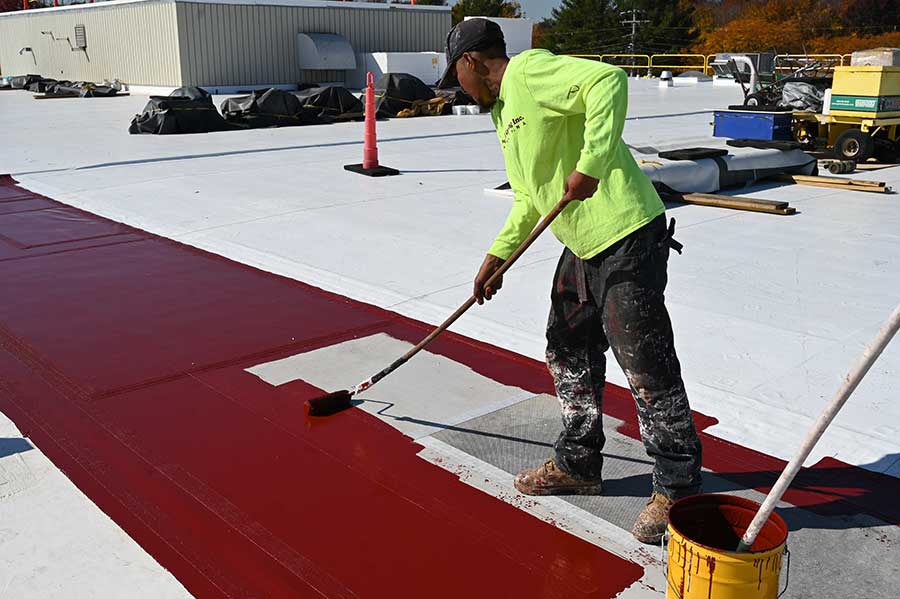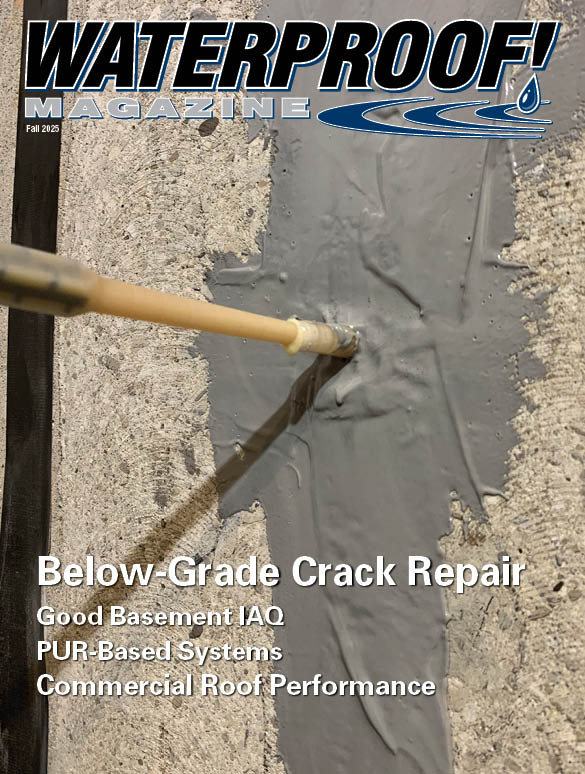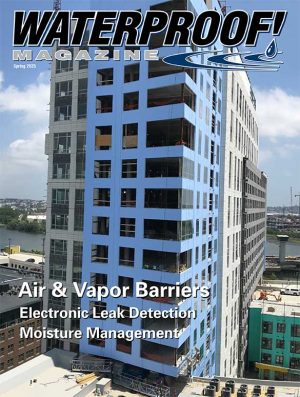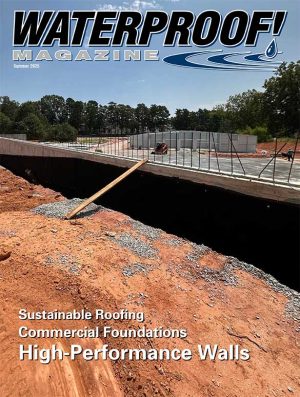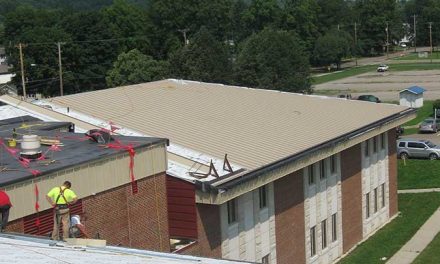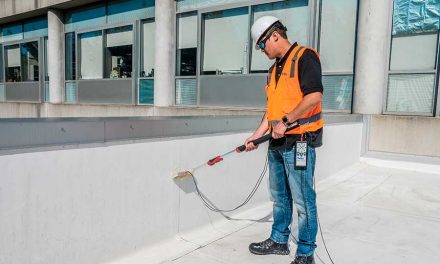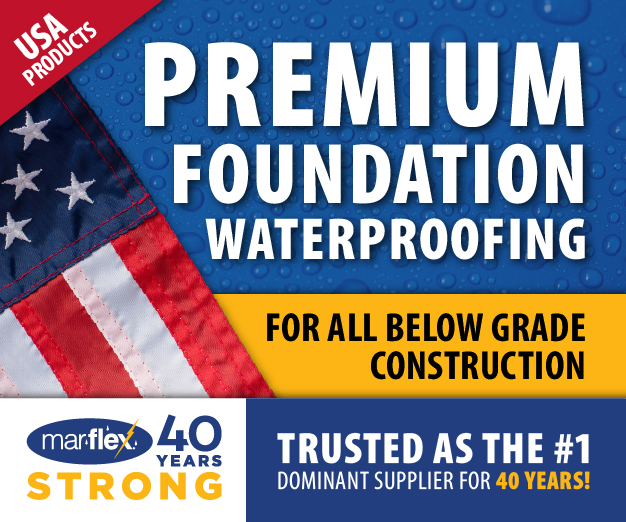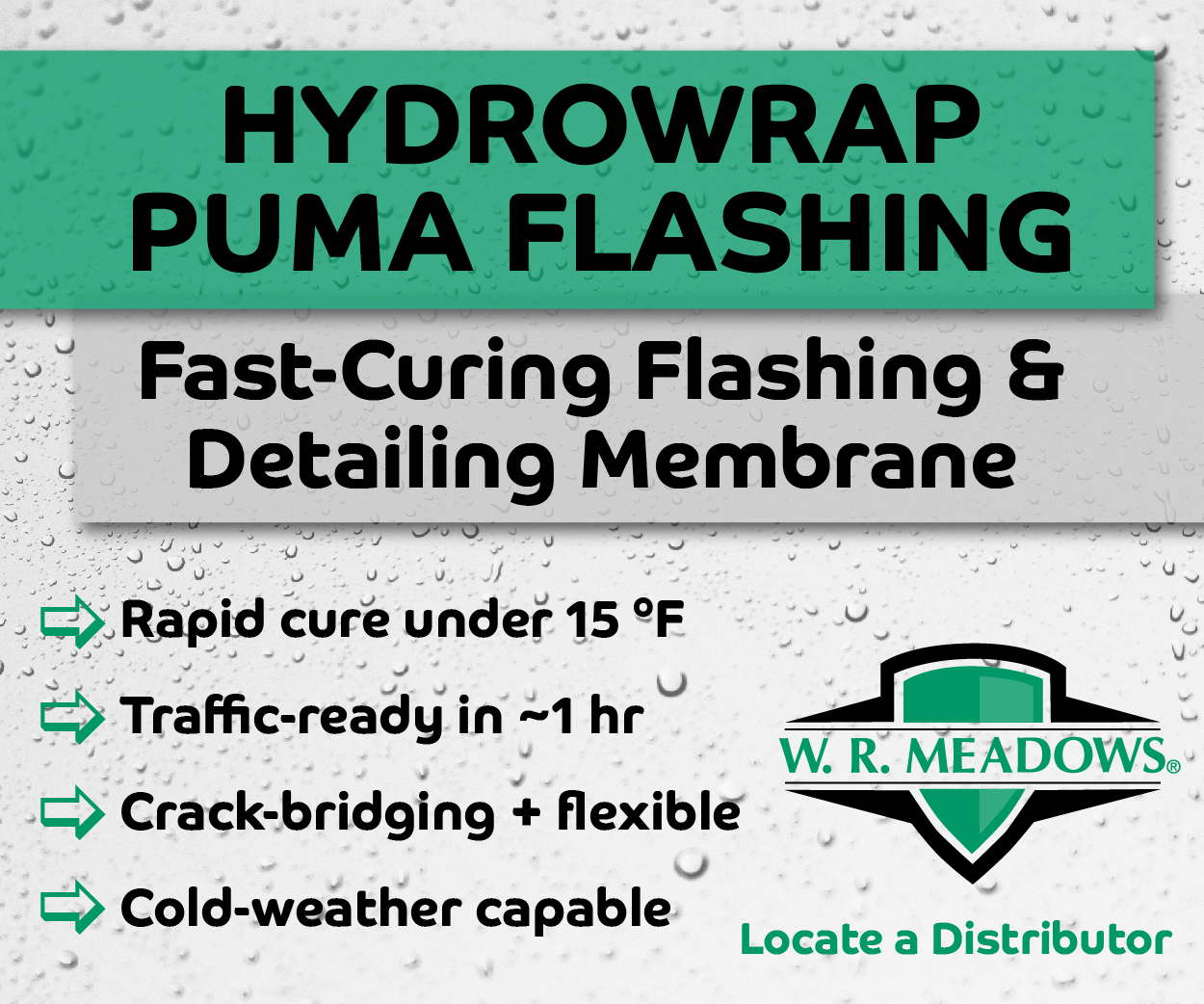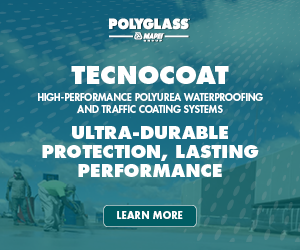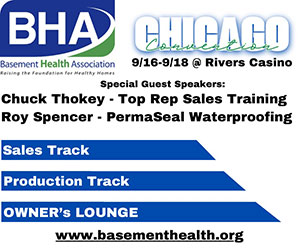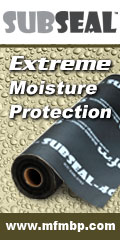By Vanessa Salvia
Photo courtesy of Sika Corp.
Application of Sikalastic EP Primer liquid applied product, a low odor, low VOC product that is fast curing and applied with either a brush or a roller onto most common substrates.
Commercial roofing presents challenges that set it apart from residential applications. “Commercial versus residential is definitely like comparing an apple and an orange,” explains Jimmy Akins, vice president of technical services, warranty, and support at Polyglass. “Commercial roofing is usually a low slope. Some people will refer to them as a flat roof. But they’re actually a low slope.”
Drainage and Slope
According to the International Building Code, commercial roofing systems require drainage built into the roof with a pitch of at least a quarter inch to ensure proper water runoff. This slight slope directs water toward drains or downspouts. Commercial roofing is often much more expansive in size than a residential roof, so without this drainage option, water accumulation would be a significant problem.
The flat nature of commercial roofs makes them particularly susceptible to UV degradation. “Anytime you have a flatter surface, you are more susceptible to the ultraviolet degradation,” Akins notes. This is especially problematic for asphaltic products and single-ply systems like EPDM rubber and TPO sheets, where UV exposure can cause the material to become brittle and prone to failure.
Why Ponding Water Kills Roofs
One of the most critical factors affecting commercial roof performance is water management. Drainage systems becoming blocked are a common occurrence on poorly maintained roofs. This ponding water creates what Akins describes as a “magnifying glass effect.”
“If you have any water sitting on the roof, then the water acts like a magnifying glass, and it’ll accelerate that process of breaking down that top surface,” he explains. For asphaltic products, this leads to the characteristic alligator-like cracking pattern, while single-ply membranes simply dry out and become brittle.
This phenomenon underscores why maintenance is so crucial for commercial roof longevity. “A lot of your commercial roofs tend to lack maintenance, which means you get a lot of buildup around the drains,” Akins observes.
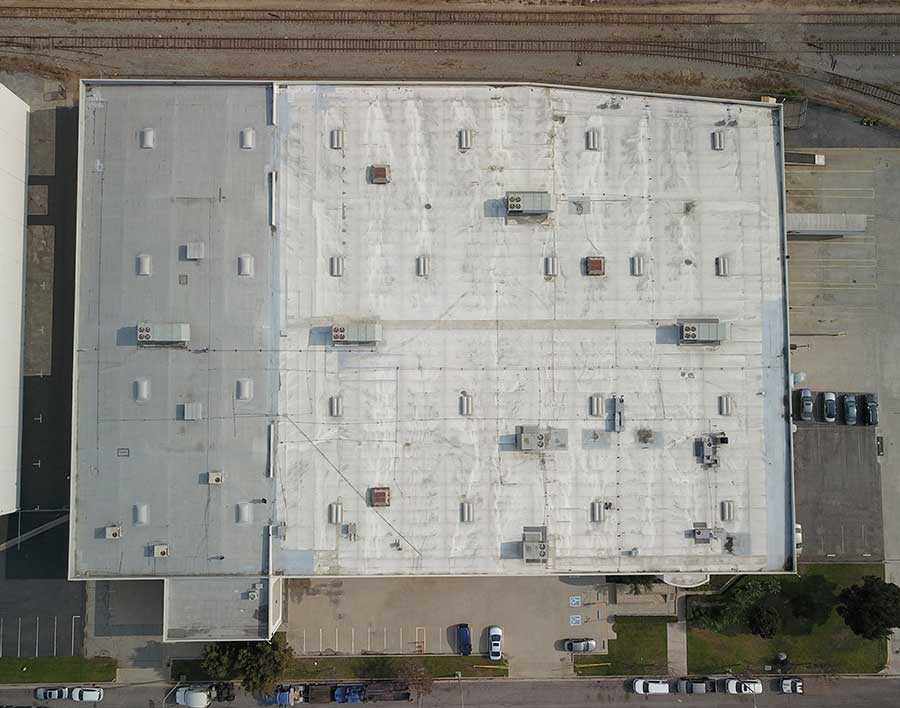
This project, shown before restoration (left) and after (right), was completed by C.I. Services Inc. using a two-part application of Polybrite 98 Primer and Polybrite 90.1 silicone coating from Polyglass’s line of silicone elastomeric roof coatings. Photos courtesy of Polyglass
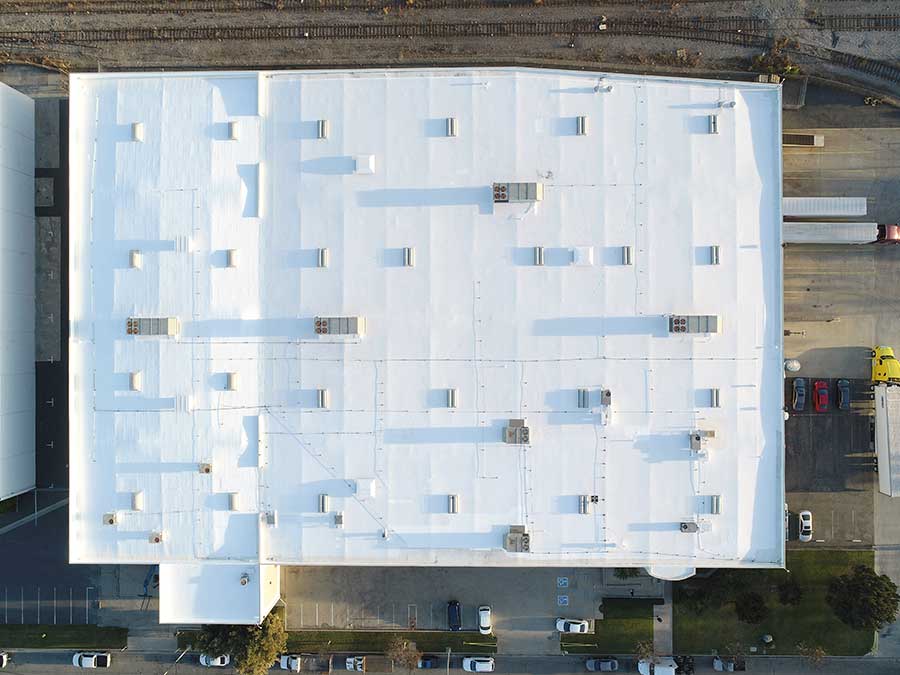
Maintenance Programs Are Key
Akins says that nine out of 10 times, the conversation about a restoration versus repair on a commercial roof comes about due to a lack of maintenance. Often, maintenance programs are abandoned when properties change hands.
“The old adage with roofing is sometimes it’s out of sight, out of mind,” Akins notes. “Unfortunately, especially in the commercial world, you may not have a long-term occupant in a building.” This transient nature of commercial property management can lead to shortened roof lifecycles due to negligence.
For waterproofing professionals advising clients, the math is clear: Maintenance wins. “If you have a roof system that’s working for you, and you invest in the roof system, a good roofing contractor is going to have a maintenance program,” Akins emphasizes.
The maintenance requirements aren’t complex or expensive. A roof needs basic protective measures similar to what you would do if you had a nice RV or a nice wooden patio on your home that you wanted to keep in good shape for years to come. Seasonal cleaning, drain maintenance, and minor repairs using silicone caulking around penetrations can significantly extend roof life. “Just by maintaining the roof, you will last the lifetime of the design. And sometimes you’ll even go past that,” he says.
Akins provides a concrete example from his own company’s experience. A Polyglass facility built in 1997 with a roof designed for a 15-year lifecycle lasted well into 2022-2023 thanks to proper maintenance and good drainage design. Rather than a complete replacement, the company applied a coating system to extend the roof’s life further.
This approach aligns with building code requirements, which typically allow only two roofing systems to be installed over existing materials before requiring a complete tear-off. For many roofs, restoration is a first and most attractive option when it is feasible.
For restoration projects, liquid-applied solutions offer viable alternatives to full replacement. However, Akins cautions that these systems require professional application. “A lot of times people make the assumption that a coating is paint, and it’s really not,” he explains. These coatings go down at heavier millage rates with more fillers and can even include reinforcement for longer-term performance.
Waterproofing professionals should also consider energy codes and utility rebate programs when advising clients. Many electric companies and municipalities offer incentives for highly reflective roofing solutions, which can offset restoration costs and provide additional value to building owners.
As a manufacturer, the Sika team always tries to work closely with the specifier community, giving feedback when requested and including recommended language in both guide specifications and warranty documentation. “We have seen a wide variety of guidance over the years, but the key thing for building owners and facilities managers to keep in mind is that a good, structured maintenance plan for your roof is the one of the key ways to avoid headaches down the line,” said Bill Bellico, vice president of marketing for Sika Corp. “What often happens with roofing is that it is out of sight, out of mind. Often, people are more focused on the building aesthetics and interiors versus what is keeping the building waterproof.
The reality though, is that it is one of the most important assets for a building. It makes up a huge percentage of your building envelope, and it is what is protecting all your assets inside, so taking the right steps to help protect that asset should be a no-brainer.”
If Bellico could give one piece of advice to someone who’s trying to get the most life out of their roof system, it would be to develop a solid preventative maintenance program. “Owners should schedule at least a bi-annual inspection schedule to go view their roof and do some basic maintenance,” he says. “Depending on geography and climate, for example, you might do a fall inspection to prepare for winter months and then again in spring after winter to make sure there were no issues suffered from winter weather.”
Check your roof out if your area experiences an extreme weather event, which might help stop a small problem from turning into a bigger one. Bellico also stresses that keeping detailed maintenance and inspection records is important, especially when there are changes over time to those who are responsible for maintenance.
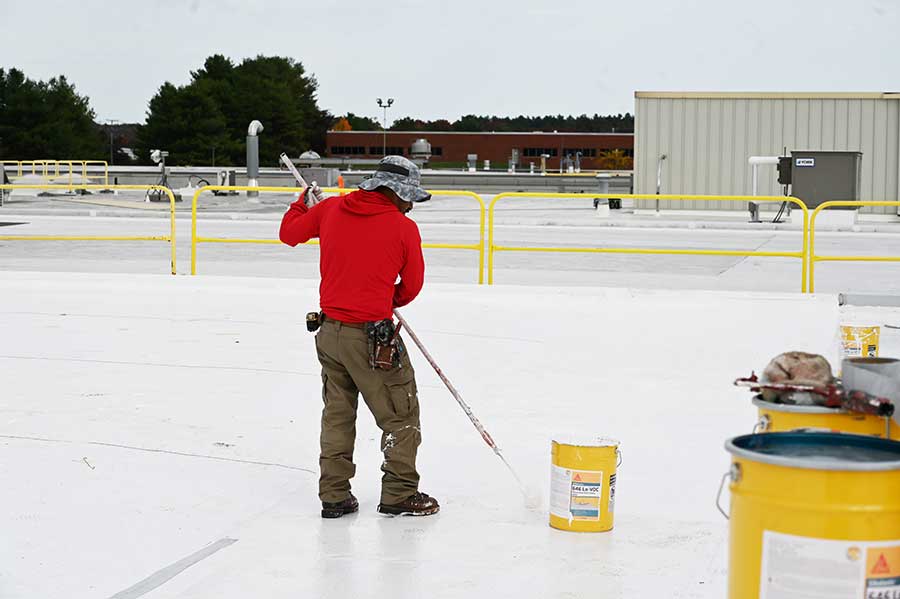
Application of Sikalastic 646 Lo-VOC product that is a cold liquid applied, highly elastic, aliphatic, single component, low odor, low-VOC moisture-triggered polyurethane resin designed for easy application as part of Sikalastic RoofCoat roofing systems. It is typically used for roof recover or roof maintenance projects. Photo courtesy of Sika Corp.
Restoration vs Replacement
A number of factors are involved in restoration versus replacement. “One key factor is the current age and conditions of the existing roof,” said Bellico.“For example, has there been water infiltration, has the insulation gotten wet, etc.”
Building codes may play a role in the decision. If there are already two roof layers on the building from a previous overlay, some form of tear-off might be the only solution available, Bellico says.
Budget can certainly also be a factor. For example, if there’s only one roof layer and the system is dry but towards the end of its service life, an overlay or coating can be more budget-friendly.
Most roofs can realistically be restored once before replacement becomes inevitable. “With a coating or liquid-applied solution, you most likely will do this one time towards the end of its service life and then when that reaches the end of its service life, most likely you will do a full replacement,” Bellico says.
This single restoration can extend total roof life to 20 to 40 years, depending on the quality of both the original system and restoration materials. While some coatings are temporary fixes, robust liquid-applied systems can last as long as new roofing with 20-year warranties, without requiring the tear-off of the existing roof.
The reliability of restoration systems varies significantly based on project goals and budget. For short-term solutions, lower-cost coating systems can add a few years of service life. “But if you are looking for something more robust, there are options available to install a new system, depending on existing conditions, without having to do a full tear-off that could buy you up to a 20-year system.”
Up-front cost is usually the first and main factor owners consider when making a roof purchasing decision, but that often overshadows some of the other most important factors, such as life cycle, durability, and maintenance, Bellico says. “What owners should look at is the track record and past performance of the roofing systems they are considering, combined with potential maintenance costs over the life cycle of the roof,” he says. “Too often, the decision is made over that initial cost, but when you don’t factor in how long the roof system will last, and how much it will cost to maintain, you might end up costing yourself more in the long run.”
For example, a more budget-friendly system may only last 15 years and potentially have unexpected maintenance costs, versus paying more initially for a roof that will last 25 to 30 years and require very little maintenance. “In the long run, you could end up costing yourself significantly more installing two roof systems in the same span as one roof and spending a lot maintaining lower quality roofs,” he says. “Your roofing/waterproofing system is one of those areas where the old adage of ‘you get what you pay for’ can be words to live by.”
Taking Action
Here is some basic advice from Akin on steps to take for long-term roofing performance:
Regular, scheduled roof visits are essential. A maintenance program costing $1,500 to $2,500 annually can prevent much more expensive replacements.
Document your repair and maintenance work. Proper maintenance records can extend manufacturer warranties. Some manufacturers will extend 20-year warranties to 25 to 30 years for well-maintained systems that receive appropriate restoration coatings.
Address issues quickly to avoid complicating future restoration efforts.
Research energy rebates and local building codes that might support restoration over replacement.
Waterproofing professionals can play a role in educating clients. Building owners need to understand that commercial roofing isn’t a “set it and forget it” investment.
The Bottom Line
The restoration versus replacement decision ultimately comes down to existing conditions, maintenance history, and long-term planning.
“There’s a lot of value in proactive maintenance as the most cost-effective approach to maximizing commercial roof performance,” Akins concludes.
Fall 2025 Back Issue
Price range: $4.95 through $5.95
PUR-Based Systems: A High-Performance Concrete Protection and Traffic Coating Solution
Breathing Easy With Good Indoor Air Quality, Starting with the Basement
Restoration vs. Replacement: Maximizing Commercial Roof Performance
Below-Grade Crack Repair Solutions
Four Decades of Proof: Why Silicone Coatings and Sealants Stand the Test of Time
Case Study: New York State Capitol Building
Description
Description
PUR-Based Systems: A High-Performance Concrete Protection and Traffic Coating Solution
By Tom Stuewe, Senior Product Manager, Siplast
In today’s fast-paced commercial construction landscape, polyurea and polyurethane-based deck coating systems have become indispensable for their exceptional combination of durability, flexibility, and performance.
Breathing Easy With Good Indoor Air Quality, Starting with the Basement
By Vanessa Salvia
Even if you don’t spend a lot of time in your basement, controlling the humidity and filtering that air before it moves to the upper levels of the home will improve your comfort and indoor air quality in the rest of the house.
Restoration vs. Replacement: Maximizing Commercial Roof Performance
By Vanessa Salvia
Commercial roofing presents challenges that set it apart from residential applications, such as being expansive surfaces that are almost flat. Proper maintenance programs can extend roof life well beyond design specifications and prevent the majority of warranty claims.
Below-Grade Crack Repair Solutions
By Vanessa Salvia
Modern techniques and materials are revolutionizing how contractors approach structural crack repair in basements, combining traditional injection methods with innovative carbon fiber reinforcement systems.
Four Decades of Proof: Why Silicone Coatings and Sealants Stand the Test of Time
By Errol Bull, Technical Services Manager at Momentive Performance Materials
How do you know if waterproofing solutions will stand the test of time? One study, started in 1983, seeks to answer that question.
Case Study: New York State Capitol Building
A centerpiece in the heart of Albany, the New York State Capitol Building’s central courtyard required updates to its roofing and cladding.
Additional Info
Additional information
| Weight | N/A |
|---|---|
| Magazine Format | Digital Download Magazine, Print Mailed Magazine |

